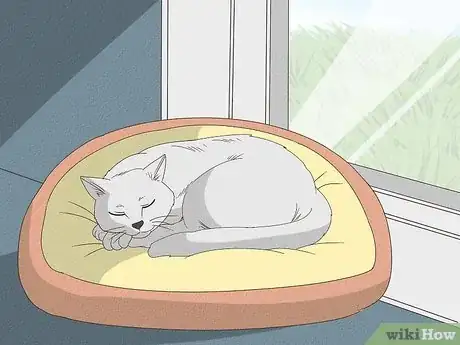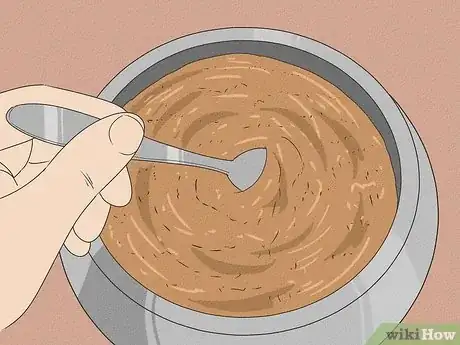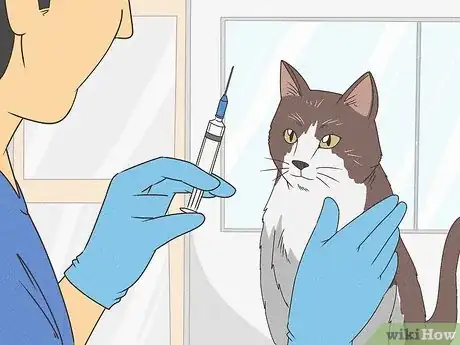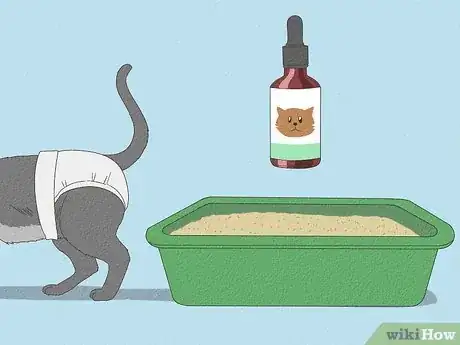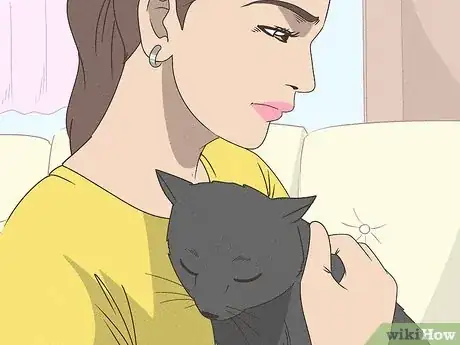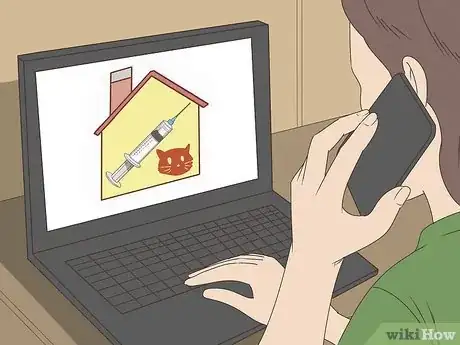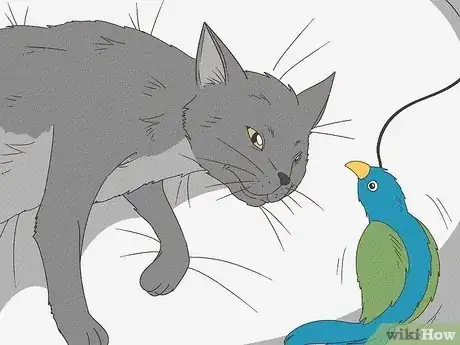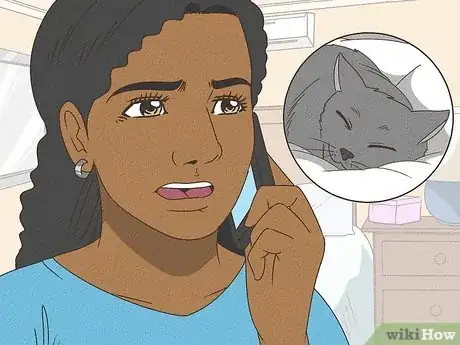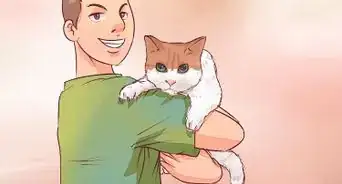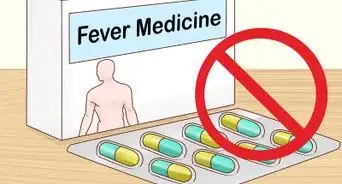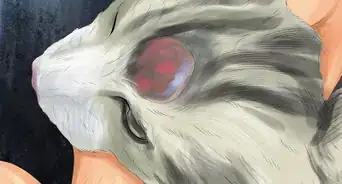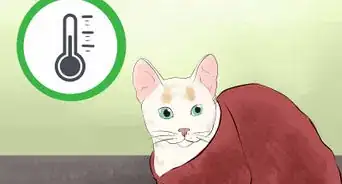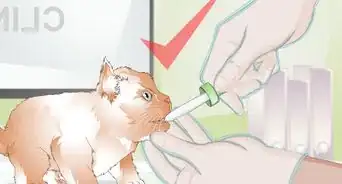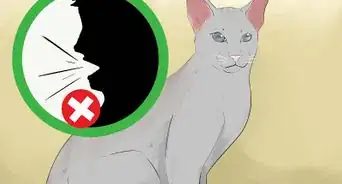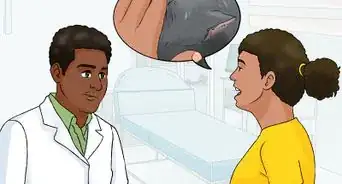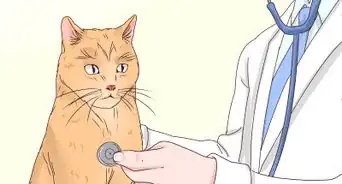This article was co-authored by Tabitha Kucera and by wikiHow staff writer, Eric McClure. Tabitha Kucera is a Registered Veterinary Technician & Cat and Dog Behavior Consultant and the Owner of Chirrups and Chatter Cat and Dog Behavior Consulting and Training in Cleveland, Ohio. Tabitha has over ten years of experience working at animal veterinary hospitals, farm sanctuaries, and cat and dog rescue centers. Tabitha has helped to develop training and behavior programs for various veterinary hospitals and shelters and works as a consultant for many shelters and private veterinary practices. Her teaching credentials include lecturing at regional and national levels and at multiple veterinary technology programs. She is a Fear Free certified speaker, a Fear Free Practice Certification Consultant, a behavior consultant for Cat Pawsitive Pro, and host of the podcast, Tails from a Vet Tech. She currently serves on the board of the Pet Professional Guild’s Cat Committee and is the President of the Society of Veterinary Behavior Technicians. She is an Elite Fear Free and Low-Stress Handling Certified Registered Veterinary Technician, a certified cat behavior consultant, a Karen Pryor Academy certified training partner, and has a Veterinary Technician Specialist (VTS) designation in behavior.
There are 19 references cited in this article, which can be found at the bottom of the page.
wikiHow marks an article as reader-approved once it receives enough positive feedback. This article received 24 testimonials and 100% of readers who voted found it helpful, earning it our reader-approved status.
This article has been viewed 444,139 times.
There’s nothing easy about losing a cat. The weeks leading up to the end of a cat’s life may be stressful and upsetting for you, but try to cherish and enjoy the remaining time you have with your kitty. Besides, the fact that you’re even looking up ways to comfort your cat at this stage in their life is a huge sign that you’ve been a wonderful friend to your cat, and they surely lived a cushy, comfy life. In this article, we’ll walk you through everything that you can do to ensure your cat crosses the rainbow bridge with comfort and dignity.
Things You Should Know
- Make your cat comfortable by giving them extra bedding, treats, and attention. Keep their food, water, and litter box nearby.
- There are no right or wrong answers when it comes to euthanasia. Talk to your vet to determine when the time is right if you’re going that route.
- Signs that your cat may be dying include weight loss, frequent hiding, lethargy, abrupt change in behavior, and an unkempt appearance.
Steps
Making Your Cat's Environment Comfortable
-
1Provide your cat with extra bedding so they can stay cozy. When your cat is reaching the end of their life, they’ll probably want to snuggle and stay comfy. Extra blankets and bedding will give them plenty of padding to lounge and snooze on. Just lay out some pillows, fluffy blankets, and cat beds at various points around your home.[1]
- The extra padding can also prevent pressure sores that could develop if they lie in one position for too long, which is a big problem for many terminally ill cats.
- The extra bedding can also serve to keep your cat warm. If your cat seems like they’re struggling to stay warm, give them a heated cat bed to rest on.
-
2Place everything your cat needs in an easy-to-reach area. Don’t make your cat go up and down stairs to get to their food, water, and litter box. To minimize your buddy’s discomfort, keep everything nearby and on the ground in an easily accessible area. Make things easy for your kitty.[2]
- Keep their favorite toys close by so they can play if they want to.
- Don’t put your cat’s litter box and food/water right next to one another. Place them in separate corners or adjacent rooms. Your cat won’t use the litter box if it’s super close to their food.
Advertisement -
3Minimize noise and activity around your cat. When your cat is nearing the end of their life, it is extremely important to give them their own space where they can relax and stay comfortable. Keep your cat’s space calm and free of noisy activity. Restrict any other loud pets to other parts of your home, don’t shout, and close the windows if it’s loud outside.[3]
- You should still talk to your cat if you normally do. Let them know how much you love them. Tell them how much they mean to you. Your cat will be comforted by your voice.
- Do not introduce your cat to new people or animals during this time. It's also not a good idea to have tons of friends come over.
- Let your cat naturally choose an area that will give them the peace and quiet they desire. Cats hang out where they want to be, so don’t force your feline to stay in an area they don’t want to be.
-
4Dim any bright lights and let natural light in for your cat. Changing the lighting for your cat can make the environment more comfortable for them. During the day, open the window shades or blinds just enough to let in some natural light. When the sun goes down, provide your cat with soft lighting.[4]
- Cats are sensitive to bright lights to begin with, but a cat nearing the end of their life will be especially bothered by super bright lighting.
-
5Set a ramp or stairs out for your cat’s favorite hangout spots. Most cats enjoy being high up off of the ground from time to time. If your cat loves sleeping in bed with you, enjoys sitting on top of your dresser, or has a favorite window perch, get some pet steps or a pet ramp to make it easy for them to climb up to their preferred hangout.[5]
- If you don’t have steps or a ramp for your cat, stack a few boxes or pieces of luggage to create a makeshift set of steps. The steps should be stable and steady and provide enough space for your cat to comfortably jump on and off.
Feeding Your Cat
-
1Give your cat tasty food that they’ll really enjoy. Earlier in your cat’s life, you limited the amount of delicious food your cat ate so that they maintained a healthy weight and diet. Now that they are near the end of their life, why not indulge them? Spoil your cat with some high-fat, gourmet canned food. Alternatively, you can give put some real tuna, tuna flakes, or tuna juice on top of their normal food.[6]
- Turkey and chicken are similarly delicious treats. Just make sure you don’t feed your cat anything with onion powder on it, since it’s highly toxic.
- If you are going to take your cat to the vet to cross the rainbow bridge, the final meal can be whatever you want. A little fried chicken, their favorite canned food, yogurt, or whatever your cat would love.
- Whichever tasty food you give them, make sure that it has a strong and appealing smell. Your cat probably won’t have a big appetite in their final days, and giving them food that is very aromatic may encourage them to eat at least a little bit.
-
2Make your cat’s food super easy to eat if they’re struggling. Your cat may be losing their appetite when they’re reaching the end, and they may even lose the physical ability to chew harder foods at all. Make things easy for them. For dry food, soften it up by soaking it in some water or mashing it. Mix up and mash wet food into softer, easy-to-eat chunks.[7]
- Other than mashing dry food, you can grind it up in a blender.
- If your vet recommends feeding your cat baby food, you can mix it with some water to make it even softer.
- Talk with your veterinarian if you are unsure what types of foods your cat can eat, and would want to eat, at the end of their life.
-
3Leave fresh water out for your cat at all times. Keeping your cat well hydrated is key to keeping them comfortable. Leave fresh water out at all times and refill it regularly so that they can stay cool and quench their thirst as needed.[8]
- If your cat isn’t drinking the way they normally do, try adding water flavoring. You can buy this stuff at any pet store. It’s designed to make the water tastier and smellier for your cat.
Managing Your Cat’s Medical Challenges
-
1Continue treating your cat’s health issues. Keep your cat comfortable by continuing to give them any treatments they’re on. Make an appointment with your veterinarian to discuss your cat’s various health challenges and what can be done to manage them.[9]
- If your cat has a terminal illness, such as cancer or chronic kidney disease, develop a plan with your veterinarian to manage and minimize your cat’s discomfort.
- Terminal illnesses often require palliative care, which refers to medical interventions designed specifically to minimize pain.
-
2Minimize your cat’s pain per your vet’s recommendations. When your cat starts to deteriorate, follow your vet’s instructions to relieve your cat’s pain and ease their suffering. Your veterinarian can recommend what type of pain medications your cat would need to achieve pain relief.[10]
- If your vet hasn’t offered up pain medication, don’t worry—your cat is probably not in pain. All illnesses are not created equal, and your cat may not need meds. Ask your vet for info here.
-
3Make sure that a large litterbox is accessible for your cat. Purchase or make a low-entrance litterbox that's 1.5 times the length of your cat's body—that way, your cat has room to move around the box without stepping in any soiled areas. Even the so-called "large" litterboxes sold in pet supply stores are too small for most cats.
- Use a large plastic storage bin to make your own low-entrance litter box. You can cut an entrance on one side to provide easier access. The high sides of these bins help contain litter when the cat digs and covers. Some cats, especially older declawed and arthritic cats, can't/don't squat to urinate and may accidentally urinate or defecate over the side of a smaller box. These bins eliminate that problem.
-
4Manage any litter box issues and help your cat stay clean. Pain, disease, or general weakness can make it very difficult for your dying cat to make it to the litter box in time. If your cat has trouble controlling their bladder, your veterinarian may want to prescribe a medication to manage the incontinence.[11]
- Something to consider: a cat losing the ability to keep themselves clean or control their bladder and bowel is considered one of the bigger signs that it may be time for euthanasia.
- Check your cat regularly for evidence of soiling or wetness. Wipe them with a wet towel to keep them clean, as needed.[12]
- Cat diapers are also available to help contain the mess.
Considering Euthanasia and Burial Options
-
1Talk with your veterinarian about when euthanasia is appropriate. While you are making the best of the time you have left with your dying cat, it’s important to be realistic about your cat’s quality of life. At a certain point, ending things may be the kinder thing to do. Talking with your veterinarian will help you handle and organize this difficult decision.[13]
- Euthanasia is a painless and humane way of ending your cat’s life. Your vet would administer an overdose of an anesthetic drug. After a few seconds, your cat would slip peacefully into unconsciousness and eventually stop breathing.[14]
- Do not feel ashamed or guilty for thinking or talking about euthanasia. Many pet owners struggle with the idea of putting their pets to sleep, even if it is recommended by a vet.
- Your veterinarian can help you sort out your emotions and questions regarding euthanasia.
-
2Decide when the time is right to end your cat’s pain. After taking your veterinarian’s advice into account, it’s up to you to determine when it’s time for euthanization. It may be helpful to look for clinical signs that your cat is clearly suffering: hiding, sleeping more, wasting away, and either withdrawing from human contact or being overly clingy.[15]
- Ask yourself, “Am I keeping my cat alive for myself or for my cat?” How you answer that question will help you decide when the time is right to euthanize them.
- One common rubric is, “Are there more good days than bad?” In other words, even if things are bad sometimes, are there more playful, pleasant days than difficult days.
-
3Schedule an appointment with your vet to perform euthanasia. When you have made the difficult decision to euthanize your cat, promptly call your veterinarian to schedule the appointment. Give yourself a few days to prepare emotionally and logistically, but don’t put it off for too long.[16]
- Give yourself enough space to mourn. Consider taking days off of work before and after work so you can spend time with your cat and then grieve in peace.
- On the day of the appointment, put your cat in the carrier and take them to the vet.
-
4Ask a vet about home euthanasia if you want your cat at home. Some veterinarians will offer to perform the euthanasia at the owner’s home. Ask your veterinarian if they offer this service. Many people prefer home euthanasia so that their cat gets to spend their final moments where they’re most comfortable.[17]
- Some people do not prefer at-home euthanasia. The idea of going through something like that where you live can be upsetting to a lot of people.
- Do not beat yourself up about this decision. You’re with your cat, and they’ll be comfy at the end regardless of where they are.
-
5Talk to your vet about what to do with your cat’s remains. You can have your cat buried at a pet cemetery or have their remains cremated. Do not feel pressured to choose one option or the other—decide what you are most comfortable with. Your vet will help you coordinate this.[18]
- Your veterinarian can give you information about pet cremation and burial services.
- If you have your cat buried at a pet cemetery, you can go visit them. However, it’s more expensive than cremating your cat.
- If you wake up to find your cat has died at home before you’ve had the opportunity to take them in for euthanization, call your vet. They’ll be able to offer guidance on what to do.
Signs Your Cat is Nearing the End of Their Life
-
1Loss of interest in food and water Often, a sudden change in how much attention your cat pays to their food and water is the first sign that something is up. If your cat is sick and they suddenly stop meowing at you when their food bowl is empty or hanging out around their water bowl when it’s empty, it could be a sign they’re entering the pre-active dying phase.[19]
- The pre-active dying phase refers to the months (or weeks) leading up to your cat’s death where the initial signs that something is wrong will develop.
- Every cat’s end of life cycle is unique, but most of these symptoms and signs will be present for most cats as they pass on.
-
2Extreme weight loss Due to the change in their eating habits (or as a result of a terminal illness), a dying cat will often lose weight fairly quickly. If you observe a major change in your cat’s weight, it may be a signal that they’re getting closer to the end.[20]
- The speed of weight loss is often an indicator of how long it will take for a cat to pass. If they start slowly shedding pounds, the pre-active dying phase may take months. If the weight loss is rapid, it may only take weeks.
-
3Radical behavioral changes Terminal illness can do strange things to a cat’s behavior. They may walk differently, make more or less noise than normal, purr at strange times, or act aggressively towards you. If you notice any kind of sudden shift in the way your cat behaves, it may be a sign that an illness is starting to wear your cat down.[21]
- Behavioral changes will often occur throughout the pre-active and active dying change.
-
4Unkempt appearance Due to the fact that they aren’t feeling well, a terminally ill cat will often forget to groom themselves. If your don’t see your cat licking themselves and their fur starts to matt, smell, or fray, they’re likely nearing the end of their life.[22]
- Your cat will often gradually slow down on the grooming gradually as they reach the end of the pre-active dying phase.
-
5Refusal to play A dying cat isn’t going to be in the mood to engage in games of chase or respond to their favorite toys. They may totally ignore you when you try to play with them or break out the catnip. This is a major sign that your cat may not be around for long.[23]
- A disinterest in play is a common sign that your cat has entered the pre-active dying phase.
-
6Lethargy A dying cat won’t be particularly active and energetic. If you notice a slow drawdown in your cat’s behavior until they’re lounging and loafing around all day, it’s a sign they aren’t feeling especially good and they may be near the end.[24]
- Slight lethargy is common during the early pre-active dying phase. Extreme lethargy (i.e. not able to get to the food bowl or litter box) is often the last sign your cat has a few days left.
-
7Frequent hiding In the days leading up to a cat’s death, they often feel weak. Since they’re incapable of fending off predators and threats, a cat’s natural instinct will be to hide. If you notice your cat is hanging out in their favorite hiding spots, it may mean they’re not doing particularly well.[25]
- Hiding is typically one of the last signs that a cat is about to pass away. If your cat continues to hide from you and other people with an uncommon frequency, they may only have a few days left.
- Frequent hiding is typically a major indicator that a cat has entered the active dying phase.
-
8Active dying typically takes 1-5 days Most cat owners notice a dramatic shift as their cat moves from the pre-active to the active dying phase. A slight loss of appetite will likely turn into a refusal to eat. General tiredness may develop into lying down for hours at a time. Once your cat begins actively dying, phone your vet for advice on what the best plan of action is.[26]
Expert Q&A
-
QuestionAt what age do cats die?
 Pippa Elliott, MRCVSDr. Elliott, BVMS, MRCVS is a veterinarian with over 30 years of experience in veterinary surgery and companion animal practice. She graduated from the University of Glasgow in 1987 with a degree in veterinary medicine and surgery. She has worked at the same animal clinic in her hometown for over 20 years.
Pippa Elliott, MRCVSDr. Elliott, BVMS, MRCVS is a veterinarian with over 30 years of experience in veterinary surgery and companion animal practice. She graduated from the University of Glasgow in 1987 with a degree in veterinary medicine and surgery. She has worked at the same animal clinic in her hometown for over 20 years.
Veterinarian The average life expectancy of a cat is a little over 15 years. This represents a spread from around 10 - 20 years, with some cats unfortunately dying at the younger end and others living to a ripe old age.
The average life expectancy of a cat is a little over 15 years. This represents a spread from around 10 - 20 years, with some cats unfortunately dying at the younger end and others living to a ripe old age. -
QuestionWhat can I give my cat for pain relief?
 Pippa Elliott, MRCVSDr. Elliott, BVMS, MRCVS is a veterinarian with over 30 years of experience in veterinary surgery and companion animal practice. She graduated from the University of Glasgow in 1987 with a degree in veterinary medicine and surgery. She has worked at the same animal clinic in her hometown for over 20 years.
Pippa Elliott, MRCVSDr. Elliott, BVMS, MRCVS is a veterinarian with over 30 years of experience in veterinary surgery and companion animal practice. She graduated from the University of Glasgow in 1987 with a degree in veterinary medicine and surgery. She has worked at the same animal clinic in her hometown for over 20 years.
Veterinarian Sadly, most human pain relievers are toxic to cats, which is why it is so important to see a vet. It's important to relieve the cat's pain, but to use a home medicine risks accidentally poisoning the cat.
Sadly, most human pain relievers are toxic to cats, which is why it is so important to see a vet. It's important to relieve the cat's pain, but to use a home medicine risks accidentally poisoning the cat. -
QuestionHow can you tell if your cat is dying?
 Pippa Elliott, MRCVSDr. Elliott, BVMS, MRCVS is a veterinarian with over 30 years of experience in veterinary surgery and companion animal practice. She graduated from the University of Glasgow in 1987 with a degree in veterinary medicine and surgery. She has worked at the same animal clinic in her hometown for over 20 years.
Pippa Elliott, MRCVSDr. Elliott, BVMS, MRCVS is a veterinarian with over 30 years of experience in veterinary surgery and companion animal practice. She graduated from the University of Glasgow in 1987 with a degree in veterinary medicine and surgery. She has worked at the same animal clinic in her hometown for over 20 years.
Veterinarian A dying cat may often hide away and seek a solitary place. In addition, they are unlikely to eat and will quickly become dehydrated. Check for this by lifting the scruff and letting go. If it sinks back slowly, the cat is dehydrated.
A dying cat may often hide away and seek a solitary place. In addition, they are unlikely to eat and will quickly become dehydrated. Check for this by lifting the scruff and letting go. If it sinks back slowly, the cat is dehydrated.
Expert Interview

Thanks for reading our article! If you'd like to learn more about treating cats, check out our in-depth interview with Tabitha Kucera.
References
- ↑ https://www.aspca.org/pet-care/general-pet-care/end-life-care
- ↑ https://vcahospitals.com/know-your-pet/managing-the-sick-cat
- ↑ https://justcatsclinic.com/feline-hospice-care-thinking-about-your-cats-end-of-life-care/
- ↑ https://faqcats.com/does-light-hurt-cats-eyes/
- ↑ https://www.vet.cornell.edu/departments-centers-and-institutes/cornell-feline-health-center/health-information/feline-health-topics/loving-care-older-cats
- ↑ http://consciouscat.net/2010/07/19/hospice-care-for-cats/
- ↑ https://consciouscat.net/2010/07/19/hospice-care-for-cats/
- ↑ https://justcatsclinic.com/feline-hospice-care-thinking-about-your-cats-end-of-life-care/
- ↑ https://www.aspca.org/pet-care/general-pet-care/end-life-care
- ↑ https://catvets.com/public/PDFs/PositionStatements/HospiceCare.pdf
- ↑ https://www.catwatchnewsletter.com/health/end-of-life-guidelines/
- ↑ https://www.aspca.org/pet-care/general-pet-care/end-life-care
- ↑ https://vcahospitals.com/know-your-pet/euthanasia-decisions-and-your-cat
- ↑ https://www.bluecross.org.uk/advice/cat/time-to-say-goodbye-to-your-cat
- ↑ https://www.bluecross.org.uk/advice/cat/time-to-say-goodbye-to-your-cat
- ↑ https://catvets.com/public/PDFs/PositionStatements/HospiceCare.pdf
- ↑ https://www.amcny.org/blog/2016/07/15/home-euthanasia-the-pros-and-cons
- ↑ https://www.oregonhumane.org/services/pet-memorials/
- ↑ https://emergencyvetsusa.com/signs-your-cat-is-dying/
- ↑ https://emergencyvetsusa.com/signs-your-cat-is-dying/
- ↑ https://emergencyvetsusa.com/signs-your-cat-is-dying/
- ↑ https://www.interviewarea.com/faq/how-do-you-comfort-a-dying-cat
- ↑ https://www.geniusvets.com/pet-care/learn/cats/cat-senior-care/what-are-signs-my-cat-dying
- ↑ https://emergencyvetsusa.com/signs-your-cat-is-dying/
- ↑ https://www.petplace.com/article/cats/pet-behavior-training/12-things-you-may-not-know-about-cat-death/
- ↑ https://www.hyaenidae.org/how-long-will-a-dying-cat-linger/
- ↑ https://www.aspca.org/pet-care/general-pet-care/end-life-care
- ↑ https://www.aspca.org/pet-care/general-pet-care/end-life-care
- ↑ http://consciouscat.net/2010/07/19/hospice-care-for-cats/
- ↑ https://vcahospitals.com/know-your-pet/memorializing-pets
About This Article
To comfort a dying cat, start by setting up a comfortable, relaxing area with plenty of soft bedding and minimal noise. Next, place your cat's litter box, food bowl, and water bowl in close proximity to the rest area so it can easily access them. Then, spoil your kitty with extra tasty foods and make sure fresh water is available at all times. Finally, if your cat is in pain, talk to your vet about pain relief medication that you can administer to make it more comfortable. For tips on helping your cat drink water or use the litter box, read on!



